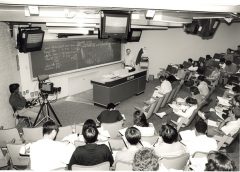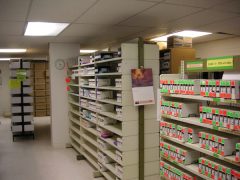By: Jeff Cohen, Assistant Director, CUOL
Did you know that Carleton University has its’ own TV channel? If yes, do you ever watch it?
If you are old enough and have lived in Ottawa long enough, the answer to both questions was probably yes at one time, but maybe not anymore.
Carleton’s cable channel started as itv in 1978, and later became CUTV, then CUOL. In 1978, cable TV subscribership was just starting to gain a foothold in the Ottawa area. itv was channel 15, and it’s safe to say that in the 20-channel universe, most cable TV subscribers routinely flipped through all the available channels and would regularly see itv, even if just passing by. It is also safe to say that with very limited alternate choices, itv, even with its unpolished production values, was often the most intellectually stimulating programming at any given time. itv had a viewership that extended well beyond enrolled students. Many of our early instructors, such as Robert Lovejoy, Charles Haines and Don Westwood, would often be recognized and engaged in conversation while out and about town. This gave Carleton University a significant community presence.
In 2004, Rogers moved itv from basic analogue service to digital service and the channel was rebranded as CUTV. Our penetration into Ottawa households plummeted. Cable TV had long lost its monopoly and relatively few households with cable had the digital service. Although digital service is now ubiquitous to cable households, the number of premium TV subscriptions is going down, especially among the age group that is the university’s primary target demographic. Meanwhile, CUTV courses were made available online and developed into the Video-on-Demand service we have today. As high-speed Internet access has practically become universal, VOD has become the most popular way, by far, for our students to take CUOL courses.
The last 10 years have seen a massive shift from cable TV to online access as the primary means of participation in CUOL courses. Now, 85 per cent plus registered CUOL students attend their courses online. Every year, the catalogue of CUOL web-based courses, only available online and not broadcast on the channel, grows in number.
So few students rely on the channel and the once significant casual viewership by the general public now appears to be negligible. Once one of two dozen, the channel is now one of 1,000. People no longer flip through the channels to see what’s on.
A university having control of a local television channel is an unusual thing and something that Carleton can be proud of. But perhaps the channel has approached its point of obsolesce? In 2011, CUTV was rebranded to CUOL, Carleton University OnLine, to reflect the importance of our online presence and the diminished role television plays in reaching our students. Perhaps it’s time to pull the cable on Carleton’s channel and direct its resources to services that better support our growing number of online students?

